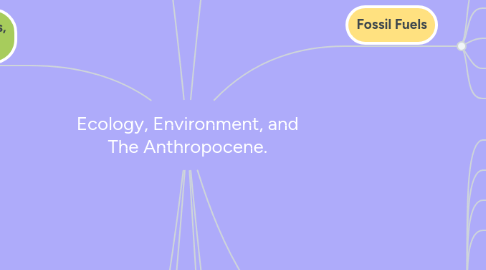
1. Ecological Footprint
1.1. Unsustainable Consumption
1.1.1. more than necessary and all at once
1.1.1.1. if the level of demand on its resource base damages the environment or depletes resources to such an extent that future generations will have lower qualities of life
1.1.1.1.1. Tomorrows World
1.1.1.1.2. Sustainable development
1.1.1.2. more than 1 billion people are overweight worldwide
1.2. Affluence: amount of resources used per person
1.2.1. Human Factor
1.2.1.1. Anthropocene: human activity is dominant part of nature
1.2.1.2. FAITH VS FACT
1.2.1.2.1. Divinity vs. Humanities
1.2.1.3. Taxonomy: classification of living things and organisms.
1.2.1.4. Symbiotic Relationships: we shape the environment, as the environment shapes us.
1.2.1.5. Population Crash: when you can not sustain population growth
1.2.1.6. Emerging Diseases, previously found in humans that typically jump from animal to a human host
1.2.1.6.1. Pandemics
1.2.1.7. Polcy
1.3. Technological Usage/ Dependency
1.4. Land transformation
1.4.1. Managed Nature
1.5. Carrying Capacity: the maximum number of individuals of a population that a particular environment can support for an indefinite period, assuming no changes in the environment.
1.5.1. standards of living
1.5.1.1. Less developed countries have the highest birth rates, lowest rate of life expectancy, and highest infant mortality rate
1.5.1.1.1. lower levels of fossil fuel usage and waste production
1.5.2. waste generation
1.5.2.1. human migration
2. Fossil Fuels
2.1. Renewable Energy
2.1.1. Efficiency
2.1.1.1. Solar, Hydropower, Wind Energy
2.2. Coal mining
2.2.1. Oil spills
2.3. Transportation + industrialization
2.4. Energy Services
2.4.1. Residential
2.4.1.1. Commerical
2.4.1.1.1. Industrial
2.5. Fracking
3. Ecology: the study of interrelationships between organisms and their environment.
3.1. Earth's systems: Climate, Atmosphere, Land, Ocean and Coastal Zones
3.2. Negative Feedback
3.3. Positive Feedback
3.4. Manage Environmental Stress
3.5. Uniformitarianism: theory that geological processes such as the laying down of sediment, erosion, and volcanic activity occur at the same rate as they did in the past
3.5.1. James Hutton: earths crust is constantly changing
3.6. Transmutation: the use of non use of body parts eventually results in features becoming stronger or weaker in species
3.6.1. Jean Baptiste Lamarck
3.6.1.1. Ladder of progress
3.6.1.2. earliest, simplest life forms derived from non living matter
3.7. Biotic Potential: the maximum rate at which a population could increase under ideal conditions.
4. Environmental Laws, Economics, and Ethics
4.1. George Perkins Marsh: "Man and Nature" Humans as agents of global environmental change (first account)
4.2. General Revision Act (1891) giving presidents the authority to establish forest reserves on federal land
4.3. Utilitarian Conservationists: viewing natural resources as opportunity for jobs
4.3.1. Theodore Roosevelt
4.4. NEPA: stating the federal government must consider the environmental impact of a proposed federal action
4.4.1. Environmental impact statements
4.4.2. Council on Environment
4.5. Environmental Ethics
4.5.1. voluntary action vs. intelligent judgement
4.5.2. Command/ Control regulations
4.6. Biocentric Preservationists: protect nature because all forms of life deserve respect and consideration
4.7. Exploitation of nature for human need
4.7.1. technological advances
4.7.1.1. camera traps and computer programs for analyzation of sound
4.7.2. urbanization, transportation industry
4.7.3. economic growth
4.7.4. zoology, botany, climatology, chemistry, physics, geology
4.8. Natural Selection: Charles Darwin (1858)
4.9. Richard Dawkins
4.10. Malthus Theory
4.10.1. A population grows or declines rapidly as long as the environmental factors for survival are constant and the rate at which that population changes increases as the population grows
4.10.1.1. more humans than food production = FAMINE
4.10.1.2. Competitive Exclusion Principal
4.11. The green revolution ---> Norman Borlaug
4.11.1. Vandava Shiva: the problems with the green revolution
5. Ecosystems
5.1. Producers
5.2. Primary Consumers
5.3. Secondary Consumers
5.4. Predators
5.5. Archaea: Prehistoric Life that exists without bacteria
5.6. Bacteria
5.7. Kingdoms; Archae, bacteria, protista, fungi, plants, animals
5.8. Eukonryota: Plants, animlas, fungi, protista
5.9. Animal Kingdoms: Phyla, Subphyla, Class, Species
5.9.1. Taxonomy
5.10. Adaptation + Cooperation = Evolution
5.11. Ecological succession
5.12. symbiosis
5.13. predation
6. The Physical Environment
6.1. Carbon Cycle
6.2. Nitrogen Cycle
6.3. Sulfur Cycle
6.4. Water Cycle
6.5. Phosphorous Cycle
6.6. Earth's Atmosphere
6.6.1. Heat inputs from the tropics and are delivered to the poles via atmosphere and ocean circulation, each delivering about 50% of the tropical heat
6.6.2. Sublimation ----> Desublimation
6.6.3. Heat + Rotation
6.6.4. Plate Tectonics
6.6.4.1. Tectonic shits
6.6.4.2. Gravitational pull
6.7. Gaia
7. Earths Ecosystems
7.1. BIOMES: determined by temperature and precipitation.
7.1.1. Atmosphere: gaseous envelope surrounding earth
7.1.2. Hydrosphere: H2O
7.1.3. Biosphere: the parts of earth's atmosphere, ocean, land, surface, and soils that contain all living things.
7.2. Tundra
7.3. Boreal Forests
7.4. Temperate Rain Forests
7.5. Temperate Decidious Forests
7.6. Temperate Grasslands
7.6.1. 90% farmland has been lost
7.7. Evergreen Shrubs
7.8. Deserts
7.9. Savannah: Tropical Grasslands
7.10. Tropical Rainforets
7.10.1. most abundant species
